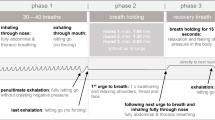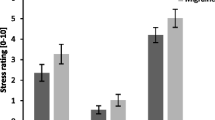Abstract
It was expected that stress and anxiety would be related to Raynaud's phenomenon (RP) attack characteristics when mild outdoor temperatures produced partial or no digital vasoconstriction. Hypotheses were that in warmer temperature categories, compared to those below 40°F, higher stress or anxiety would be associated with more frequent, severe, and painful attacks. The Raynaud's Treatment Study recruited 313 participants with primary RP. Outcomes were attack rate, severity, and pain. Predictors were average daily outdoor temperature, stress, anxiety, age, gender, and a stress-by-temperature or an anxiety-by-temperature interaction. Outcomes were tested separately in multiple linear regression models. Stress and anxiety were tested in separate models. Stress was not a significant predictor of RP attack characteristics. Higher anxiety was related to more frequent attacks above 60°F. It was also related to greater attack severity at all temperatures, and to greater pain above 60°F and between 40° and 49.9°F.
Similar content being viewed by others
REFERENCES
Bird, E. I., Wilson, V. E., and Blanchard, E. B. (1985). Characteristics of stress clinic attendees. Biofeedback Self Regul. 10(4): 343–348.
Boey, K. W., Chan K. B., Ko, Y. C., Goh, L. G., and Lim, G. C. (1997) Work Stress and psychological well-being among the nursing profession in Singapore. Singapore Med. J. 38(6): 256–260.
Cohen, S., Kamarck, T., and Mermelstein, R. (1983). A global measure of perceived stress. J. Health Soc. Behav. 24: 385–396.
Cooke, J. P., Creager, M. A., Osmundson, P. J., and Shepherd, J. T. (1990). Sex differences in control of cutaneous blood flow. Circulation 82: 1607–1615.
Corbin, D. O., Wood, D. A., MacIntyre, C. C., and Housley, E. (1986). A randomized double-blind cross-over trial of nifedipine in the treatment of primary Raynaud's phenomenon. Eur. Heart J. 7: 165–170.
Droste, H., Wollersheim, H., Reyenga, J., and Thien, T. (1990). Vascular and humoral sympathetic nervous system reactivity during mental arithmetic in primary Raynaud's phenomenon. Int. Angiol. 9: 84–89.
Duffy, C. M., Laxer, R. M., Lee, P., Ramsay, C., Fritzler, M., and Silverman, E. D. (1989). Raynaud syndrome in childhood. J. Pediat. 114: 73–78.
Edwards, C. M., Marshall, J. M., and Pugh, M. (1998) Lack of habituation of the pattern of cardiovascular response evoked by sound in subjects with primary Raynaud's disease. Clin. Sci. 95: 249–260.
Ettinger, W. H., Wise, R. A., Schaffhauser, D., and Wigley, F. M. (1984). Controlled double-blind trial of dazoxiben and nifedipine in the treatment of Raynaud's phenomenon. Am. J. Med. 77: 451–456.
Finley-Jones, R., and Brown, G. W. (1981) Types of stressful life events and the onset of anxiety and depressive disorders. Psychol. Med. 11(4): 803–815.
Freedman, R. R., and Ianni, P. (1983). Role of cold and emotional stress in Raynaud's disease and scleroderma. Br. Med. J. 287: 1499–1502.
Freedman, R. R., and Ianni, P. (1985). Effects of general and thematically relevant stressors in Raynaud's disease. J. Psychosom. Res. 29: 275–280.
Freedman, R. R., Lynn, S., and Ianni, P. (1982). Behavioral assessment of Raynaud's disease. In Keefe, F., and Blumenthal, J. (Eds.), Assessment Strategies in Behavioral Medicine, Grune and Stratton, New York, pp. 99–130.
Gjorup, T., Hartling, O. J., Kelbaek, H., and Nielsen, S. L. (1986a). Controlled double-blind trial of nisoldipine in the treatment of idiopathic Raynaud's phenomenon. Eur. J. Clin. Pharmacol. 31: 387–389.
Gjorup, T., Kelbaek, H., Hartling, O. J., and Nielsen, S. L. (1986b). Controlled double-blind trial of the clinical effect of nifedipine in the treatment of idiopathic Raynaud's p]henomenon. Am. Heart J. 111: 742–745.
Halperin, J. L., Cohen, R. A., and Coffman, J. D. (1983). Digital vasodilatation during mental stress in patients with Raynaud's disease. Cardiovasc. Res. 17: 671–677.
Hugdahl, K., Fagerstrom, K., and Broback, C. (1984). Effects of cold and mental stress on finger temperature in vasospastics and normal Ss. Behav. Res. Ther. 22: 471–476.
Kleinbaum, D. G., Kupper, L. L., and Mutter, K. E. (1988). Applied Regressional Analysis and Other Multivariate Methods, 2nd ed., PWS-Kent, Boston, MA.
Maricq, H. R., Carpentier, P. H., Weinrich, M. C., Keil, J. E., Palesch, Y., Biro, C., Vionnet-Fuasset, M., Jiguet, M., and Valter, I. (1993). Geographic variation in the prevalence of Raynaud's phenomenon, a five region comparison. J. Rheumatol. 20: 70–76.
Maricq, H. R., Weinrich, M. C., Keil, J. E., and LeRoy, E. C. (1986). Prevalence of Raynaud phenomenon in the general population. J. Chronic Dis. 39: 423–427.
Martinez, R. M., Saponaro, A., Dragagna, G., Santoro, L., Leopardi, N., Russo, R., and Tassone, G. (1992). Cutaneous circulation in Raynaud's phenonmenon during emotional stress. A morphological and functional study using capillaroscopy and laser-Doppler. Int. Angiol. 4: 316–320.
Melin, B., and Sandqvist, D. (1994). Effects of thematically relevant visual stimuli in Raynaud's disease. Scand. J. Behav. Ther. 23: 53–60.
National Oceanic and Atmospheric Administration (1994). National Climatic Data Center Bulletin Board System User's Manual, Vers. 1.1, U.S. Dept. of Commerce, Washington, DC.
Raynaud's Treatment Study Investigators (2000). Comparison of sustained-release nifedipine and temperature biofeedback for primary Raynaud's phenomenon: Results from a randomized clinical trial with one-year follow-up. Arch. Int. Med. 160: 1101–1108.
Rodeheffer, R. J., Rommer, J. A., Wigley, F., and Smith, C. R. (1983). Controlled double-blind trial of nifedipine in the treatment of Raynaud's phenomenon. New Engi. J. Med. 308: 880–883.
Sarkozi, J., Bookman, A. A., Mahon, W., Ramsay, C., Detsky, A. S., and Keystone, E. C. (1986). Nifedipine in the treatment of idiopathic Raynaud's syndrome. J. Rheumatol. 13: 331–336.
SAS Institute Inc. (1989). SAS/STAT users guide, Vol 2., 4th ed, The SAS Institute, Cary, NC.
Schcherbakov, A. B., Guseva, N. G., and Mach, Z. S. (1993). The role of sympathetic reactivity in the development of Raynaud's syndrome. Terapevtichtskii Arkhiv 65: 22–25.
Sedlacek, K. (1979). Biofeedback for Raynaud's disease. Psychosomatics 20: 535–541.
Sedlacek, K. (1989). Biofeedback treatment of primary Raynaud's disease. In Basmajian., J. V. (Ed.), Biofeedback: Principles and Practice for Clinicians, 3rd ed., Williams and Wilkins, Baltimore, Md; pp. 317–321.
Selacek, K., and Taub, E. (1996). Biofeedback treatment of Raynaud's disease. Profess. Psychol. Res. Pract. 27: 548–553.
Spielberger, C. D. (1983). Manual for the State-Trait Anxiety Inventory (Form Y), Consulting Psychologist Press, Palo Alto, CA.
Surwit, R. S. (1982). Behavioral treatment of Raynaud's syndrome in peripheral vascular disease. J. Consult. Clin. Psychol. 50: 922–933.
Surwit, R. S., Williams, R. B. Jr., and Shapiro, D. (1982). Behavioral Approaches to Cardiovascular Disease, Academic Press, New York.
Valter, I., and Maricq, H. R. (1998). Prevalence of Raynaud's phenomenon in two ethnic groups in the general population of Estonia. J. Rheumatol. 25: 697–702.
Ware, J. E., Snow, K. K., Kosinski, M., and Gandek, B. (1993). SF-36 Health Survey: Manual and Interpretation Guide, Nimrod Press, Boston, MA.
Weinberg, A., Creed, F. (2000). Stress and psychiatric disorder in healthcare professionals and hospital staff. Lancet 355: 533–537.
Weinrich, M. C., Maricq, H. R., Keil, J. E., McGregor, A. R., and Diat, F. (1990). Prevalence of Raynaud's phenomenon in the adult population of South Carolina. J. Clin. Epidemiol. 43: 1343–1349.
Wollershiem, H., Droste, H., Reyenga, J., and Thien, T. (1991). Laser Doppler evaluation of skin vasomotor reflexes during sympathetic stimulation in normals and in patients with primary Raynaud's phenomenon. Int. J. Microcirc. Clin. Exp. 10: 33–42.
Rights and permissions
About this article
Cite this article
Brown, K.M., Middaugh, S.J., Haythornthwaite, J.A. et al. The Effects of Stress, Anxiety, and Outdoor Temperature on the Frequency and Severity of Raynaud's Attacks: The Raynaud's Treatment Study. J Behav Med 24, 137–153 (2001). https://doi.org/10.1023/A:1010758530555
Issue Date:
DOI: https://doi.org/10.1023/A:1010758530555




